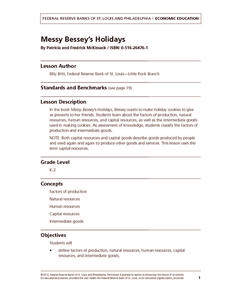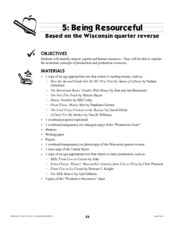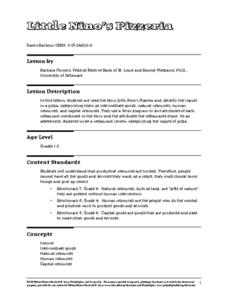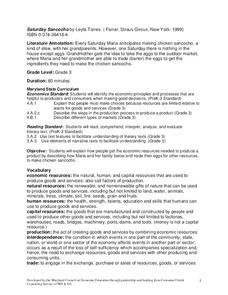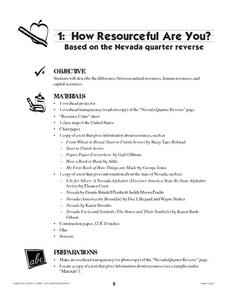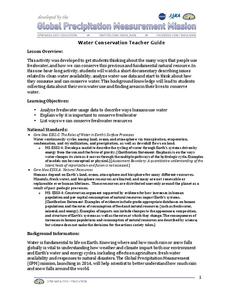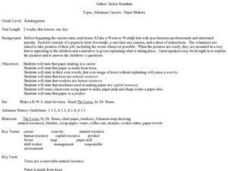Curated OER
Lemonade For Sale
2-3rd graders listen to the story, Lemonade for Sale, by Stuart J. Murphy. In the story, children produce and sell lemonade to raise money for their clubhouse, create a product, classify the resources used in production as natural...
Carolina K-12
Factors of Production and Economic Decision-Making
Class members begin this engaging economics activity by listing all the resources used in producing a car and using that example to draw parallels to the four primary factors of production: capital goods, labor, natural resources, and...
Center for Entrepreneurship and Economic Education
Popcorn Economics
Scarcity of resources is a fundamental economics concepts that kids need to understand. You'll use a large bag of popcorn to demonstrate this concept. Have the class come up row-by-row to fill their snack bags with popcorn. By...
Curated OER
Three Little Pigs: Human, Natural and Capital Resources
First and second graders will learn about natural, capital , and human resources through the story The Three Little Pigs. They will listen to the story, write down what they know about straw, wood, and brick, then complete a chart...
Federal Reserve Bank
Messy Bessey's Holidays
Teach your class some fairly complex terms—factors of production, human resources, capital resources, natural resources, and intermediate goods—with a storybook (Messy Bessey's Holidays), plenty of visuals and handouts, and related...
Curated OER
Being Resourceful: Wisconsin quarter reverse
If your class understands goods and services then they'll be ready for this activity on various resources. After reading a series of books and engaging in class lecture and discussion, pupils will fill out worksheets. They will list...
Federal Reserve Bank
Little Nino's Pizzeria
Engage your youngsters in basic economics by connecting the terms to dessert and pizza! After a discussion about intermediate goods and natural resources, learners read and connect a pizzeria to economic terms.
Curated OER
Little House In the Big Woods
Students explore economics by reading classic literature with their classmates. For this farm production lesson, students read the famous story Little House in the Big Woods by Laura Ingalls Wilder. Students complete handouts based upon...
Curated OER
A Differentiated Way through Think Dots
Young scholars examine reasons that led people to explore, identify "West" as defined following Revolutionary War, explain importance of finding natural resources, develop time line of dates and events leading up to Lewis and Clark...
Curated OER
Saturday Sancocho
Second graders identify the economic principles and processes that are helpful to producers and consumers when making good decisions. Students will read, comprehend, interpret, analyze, and evaluate literary text as well as explain how...
Curated OER
How Resourceful Are You?
Students investigate the concept of resources. They differentiate between natural, human, and capital resources. Prior to the lesson the students need to build background knowledge of goods, services, needs, and wants. They create a...
Curated OER
The Goat in the Rug
Young scholars define productive, capital, human and natural resources and intermediate goods, then classify these things by how they are used in a production process. In this resources/goods lesson plan, students listen to the story The...
Curated OER
How Resourceful Are You?
Students examine the Nevada state quarter and discuss items on the quarter, categorizing them as natural resources, human resources, or capital resources. They paste other coins into correct categories depending on the resources depicted...
Curated OER
Water Conservation
Open learners' eyes to the challenge of finding safe drinking water – something we often take for granted in our country. The PowerPoint presentation includes images, graphs, diagrams, and even a video to stimulate discussion on how we...
Global Oneness Project
The Nature of Happiness
The U.S. Constitution states that the pursuit of happiness is an inalienable right. The United Nations' Global Happiness Index ranks countries according to the happiness of its citizens. As part of a discussion of the nature of...
Carolina K-12
Comparing Economic Systems
How do people make decisions in a world where wants are unlimited but resources are not? How do individuals and governments utilize scarce resources (human, natural, and capital) in different economic systems? Introduce your learners to...
Curated OER
Harvesting Hope: The Story of Cesar Chavez
Learners identify productive resources that are important to migrant workers. In this instructional activity on resources, students give examples of natural resources, human resources and capital resources that apply to migrant workers....
Curated OER
Resources of the Three Little Pigs
Second graders, after listening to the The Three Little Pigs, identify the natural, human, and capital resources involved in creating each house.
Curated OER
Create a Country
Young scholars work in small groups to list features and elements found on a variety of grade- appropriate maps. They develop a class list of map features and elements to draw from as they create a map of an imaginary country.
Curated OER
Teaching Economics Using LUNCH MONEY
Students, after reading the book "Lunch Money" by Andrew Clements, explore money and different saving places. They research different ways in which productivity has increased over the years, they examine products to determine if the...
Curated OER
Classifying Resources
Learners discuss the difference between the three types of productive resources. In groups, they classify and organize examples into the correct category on a chart. As a class, they discuss how each type is used in the production of a...
Curated OER
Arkansas Careers - Paper Makers
Students listen to the story The Lorax. They identify natural, human and capital resources in the book. They identify the scarcity problem and brainstorm solutions. Students view a map of Arkansas which shows natural resources. They...
Curated OER
Lesson 1
Students understand the meaning of natural resources. They distinguish between renewable and non-renewable natural resources. To help students identify natural resources as either non-renewable or renewable. To stimulate student thinking...
Curated OER
Earth Bags
Students discuss the environment and the problems facing our natural resources. They write ways to help the environment on paper grocery bags, illustrate them, and distribute them to grocery stores to be used with customers.




